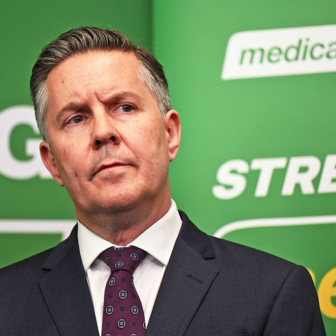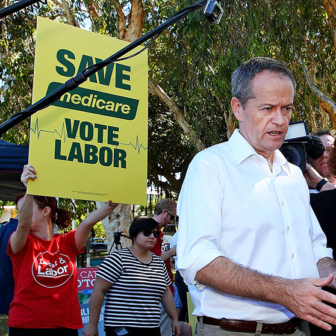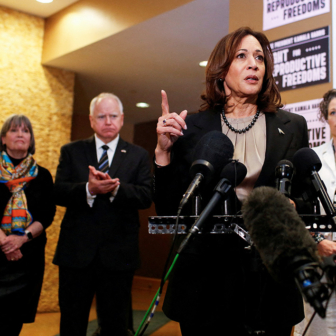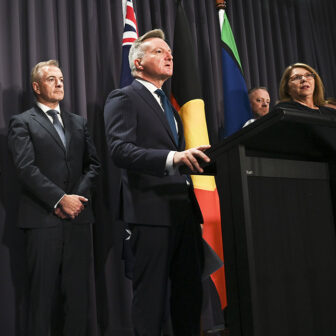So swine flu is now, possibly, past us – or possibly not. Once again the media have been whipped into a frenzy of excitement about a killer flu, with the possibility of the world turning into a post-apocalyptic wasteland as millions die and the entire fabric of society collapses around us. Surprisingly, one of the few rational voices in the debate was Andrew Bolt of the Herald Sun, who was savvy enough to point out that this type of scaremongering occurred during the Hong Kong flu of 1968–70 and, more recently, the bird flu scare, neither of which caused any deaths in Australia.
But Bolt missed the mark when he criticised the government for raising awareness about the possibility of swine flu, or H1N1 influenza, making it to Australia, and what that could mean for our national health.
The federal government has a comprehensive influenza pandemic plan, which was put together in consultation with a large number of medical, veterinary, epidemiological and public health bodies. These groups report through a string of committees, but ultimately to AHMAC, the Australian Health Ministers Advisory Committee, and through that to the Minister of Health. Key decisions about Australia’s response to a pandemic (quarantine, closure of schools, immunisation stockpiles, etc) are thus well informed and taken in a generally responsible way.
What can’t be controlled by the public health and virology experts, of course, is the overreaction to plans to introduce thermal scanners at international terminals and to the release of advice to GPs and communities on what to do should symptoms of influenza appear. These responses are usually hysterical and concentrate on poor statistics and worse scientific methodology, with the level of fact checking usually reserved for identifying old photos of Pauline Hanson.
Pandemics, by definition, occur when influenza (in this case) affects individuals across every continent. And with Australia’s first confirmed case appearing this week, swine flu is in at least five continents.
Influenza is divided into three types: A, B and C. A and B are responsible for major outbreaks, while C is usually responsible for the common cold in children. Influenza B is confined to humans, and influenza A is present in many species. Both A and B carry proteins on the surface of the virus, the antigens, which determine the body’s response to the virus. These are the Haemagglutinin (H) and the neuraminidase (N) proteins. As these proteins have a high tendency to change – a phenomenon known as antigenic shift – new types of influenza are continually developed.
Initially animal influenza – swine, bird, equine or whatever – is confined to animals, but with antigenic shift it becomes transmitted to and causes illness in humans. At first, this infection is only possible after contact with an infected animal (as in early bird flu, affecting only poultry workers), but with further antigen changes it becomes transmissible from person to person. At this stage it is usually an epidemic, confined to a particular region, but with rapid and relatively easy air travel epidemics quickly become pandemics and local governments have to prepare for the eventuality that influenza reaches their shores and causes widespread local infection.
To that end Australia has an influenza pandemic plan which is divided into six phases similar to, but independent of the World Health Organisation’s classification. This allows the government to act regardless of the advice coming from the WHO. Currently, we are at level OS6 Delay, which basically means that the pandemic originated overseas and is not yet in Australia. The goal of this stage, not surprisingly, is to prevent or delay entry of the virus into the country and start preparing our response in the eventuality that it does arrive. But all that really means is that we distribute information to health professionals, check our vaccination levels and install thermal scanners into airports. It also means that the government informs the press that this is what is happening and then tries to minimise the hysteria.
Australia’s influenza response is based on the 1918 Spanish flu that killed twenty million people worldwide, spread by returning servicemen from the European battlefields at the end of the first world war. Putting things in perspective, about 2400 people die in Australia every year from influenza and pneumonia. Under the Spanish flu paradigm, the government estimates that 40 per cent of the population would be affected (8.5 million), and 200,000 people would die. It also estimates that absenteeism in the workplace could reach 50 per cent.
Obviously these figures are scary, but the government uses flawed logic by not accounting for updates in public health planning, information technology and the general nutritional wellbeing and health of the community. Swine flu, like bird flu before it, has taken hold predominantly in developing nations where general health and nutrition are poorer than here. In addition differences in infrastructure and population density (eighteen million people live in Mexico city with a population density of 8700 per square kilometre, compared with 3.4 million people in Melbourne with a population density of 1600/sqkm) mean that the transmissibility of the influenza virus is far higher in Mexico, where swine flu first crossed from pig to human, than in Australia.
There are two sides to every story, however, and as the Victorian government grapples with the aftermath of the Black Saturday bushfires, one of the recurring themes is the underpreparedness of the general population, the CFA and the rest of the emergency services. Yes, this was a once in a century fire, but that’s what they said about Black Friday in 1939 and Ash Wednesday in 1983. It’s not hard to imagine the response from the tabloid media should an underprepared government allowed Influenza H1N1 to come into Australia and explode out of control with even 240 deaths, let alone 2400. So a federal health minister who suggests that we think as far ahead as next week, and what we are going to do with our children if the schools are closed down, is probably trying to provide useful advice as to the potential actions that may need to be taken, rather than saying, “Load your shotguns and run for the hills, we’re all going to die.” •




